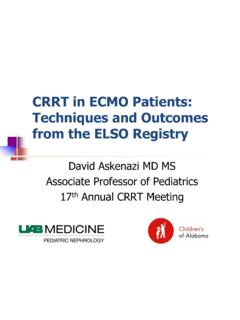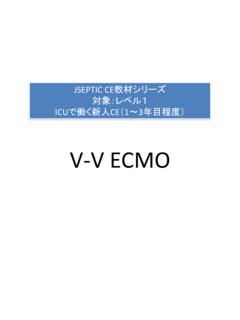Transcription of Mechanical Ventilation in the Pediatric Emergency …
1 4/6/20141 Mechanical Ventilation in the Pediatric Emergency Room & Intensive Care UnitShaji Pillai, MD04/03/14 The University of Kansas HospitalDisclosures I have no disclosures to report4/6/20142 Objectives History of Mechanical Ventilation in children A brief overview of types of Ventilation available Indications and challenges of the non-invasive Ventilation modes Indications and challenges of the advanced invasive Ventilation modesHistory of Mechanical Ventilation First written idea of assisted Ventilation : Galen of Pergamon(~175 AD) Use of bellows to inflate the lungs of deceased animals Discovered the larynx produced your voice First idea of external negative pressure Ventilation : John Mayow (1638) First negative pressure ventilator: John Dalziel (1832) First tank respirator : Patient sitting in an air tight box with head sticking out with manual bellows4/6/20143 History of Mechanical Ventilation The first widely used negative pressure ventilator: The Drinker Respirator (aka Emerson Iron Lung) Designed by Philip Drinker and Louis Agassiz Shaw Jr.
2 (1928) Powered by an electric motor and 2 air pumps from a vacuum cleaner First ever use: 8 yr old girl w/ Poliomyelitis at Boston Children s Hospital 1928 History of Mechanical Ventilation Emerson Iron LungHilpertshauser, Mary. Iron Lung CDC. Digital image. Wikipedia, 2004. Web. 01 Apr. of Mechanical Ventilation Boston Children s Hospital 4 patient chamber ventilatorHistory of Mechanical Ventilation Movement away from negative pressure devices (1960s) Large, taking up much space, difficult to access patient No PEEP Significant leakage leading to patient cooling Tank shock blood pooling in abdomen and lower extremities Intermittent positive pressure breathing (IPPB) (1950s) Brief boost of positive airway pressure in patients with chronic respiratory failure or to deliver aerosolized bronchodilator to COPD patients Studies failed to demonstrate benefit over aerosol treatment alone via nebulizer4/6/20145 History of Mechanical Ventilation Invasive Positive Pressure machines First generation 1940s to 50s Only volume controlled No patient triggered ventilations No PEEP No monitors Second generation Simple monitors TV and RR Patient triggered ventilations IMV, SIMV introduced (only volume control) Third generation Ex Servo 300, Bear 1000 Addition of microprocessor Markedly more responsive to patient demand SIMV w/ Pressure control, APRV More bells and whistles (literally)
3 Fourth generation Current generationTypes of Mechanical Ventilation Non-invasive Mechanical Ventilation Negative Pressure Ventilation (NPV) Noninvasive Positive Pressure Ventilation (NIPPV) CPAP, BiPAP, HHNC Conventional Invasive Mechanical Ventilation CMV, AC, VC, IMV, SIMV Advanced Ventilation HFOV APRV ECMO (V-V and V-A)4/6/20146 Challenges to Ventilation in children Smaller airway Multiple sized tubes and blades based on weight/size Mask sizes available at hand that are too big or too small Appropriate tubing for Pediatric patients Fear of the machine, the staff, or the surroundings Sensory issues Hunger Sedation, Sedation, Sedation!Noninvasive Ventilation Positive effects Decreases work of breathing Increases functional residual capacity Stabilizes chest wall to reduce retractions Recruits alveoli with PEEP Increases tidal volume and minute Ventilation Maintains upper airway patency Benefits over endotracheal intubation Decrease upper airway trauma No vocal cord dysfunction Less sedation needed No need for paralytics Less risk of aspiration Patients can still communicate If successful, fewer oxygen days leading to less oxygen toxic side effects (ROP)
4 4/6/20147 Types of noninvasive Ventilation techniques CPAP Continuous positive pressure Ventilation Constant pressure during inspiration and expiration 5-10 cm H2O Delivered by binasal prongs, oronasal masks, nose masks, or nasopharyngeal prongs Nasal CPAP used to great effect in the Neonatal ICU BiPAP Bi-level positive airway pressure Provides 2 levels of positive airway pressure during respiratory cycle Higher pressure IPAP during inspiration (10-16 cm H2O) Lower pressure EPAP during expiration (5-10 cm H2O) Set rate or back-up rate Can be patient triggeredTypes of noninvasive Ventilation techniques Humidified high-flow nasal cannula (HHFNC) Delivers warm, humidified air Up to 8 L/min in infants and 40 L/min for older children Less nasal irritation Comparable to nasal CPAP Nasal intermittent positive pressure Ventilation (NIPPV) Provides periodic increases in positive pressure above a baseline fixed pressure Has 2 flow meters compared to nasal CPAP s 1 in order to add additional flow Additional flow delivered at set rate, not patient triggered4/6/20148 Contraindications to NIV Impaired mental status Poor cooperation Agitation Inability to protect the airway Recent upper GI surgery Hemodynamic instability/shock Inappropriate mask size/type availableNoninvasive Ventilation How do you know if it s working?
5 Assess within 1-2 hours Note if patient is tolerating it to start Decreased respiratory rate, retractions, or work of breathing Airway occlusive events decreased Improved lung volumes noted O2saturation improved How do you know if it s failed? Persistent or progressive respiratory distress and/or tachypnea Tired appearance/worsening mental status Increased agitation/anxiety Vomiting, excessive secretions Hemodynamic instability Persistent hypoxia4/6/20149 Noninvasive Ventilation when to use it? Chronic patients Nocturnal hypoventilation Chronic respiratory failure patients with restrictive chest wall deformities and neuromuscular disease Can delay need for tracheostomy and be effective in acute exacerbations Cystic fibrosis patients Can bridge to lung transplants in end stage lung diseaseNoninvasive Ventilation when to use it?
6 Acute patients Pneumonia Maybe? Little concrete evidence to support improved outcomes Fortenberry et al described improvement of 25 out of 28 patients on BiPAP with concurrent pneumonia and neurologic disorders - avoided intubation Asthma Possibly? Specifically status asthmaticus Teague et al showed 19 of 26 patients improved on BiPAP decreased RR and work of breathing Joshi et al showed improvement in RR, PCO2, and oxygen requirement for 18 of 29 patients for primary parenchymal disease but no improvement in O2saturation Bronchiolitis Some evidence shows improvement in number of O2 days and reduced number of ventilator associated infections (Dels, Estrada & Abramo, 2009) Acute Chest Some evidence to support initiation of BiPAP on patients with acute chest to significantly reduce HR, RR, and O2requirement (Dels, Estrada & Abramo, 2009)
7 4/6/201410 Noninvasive Ventilation strategies for children Start easy, work your way up Appropriate mask size and fit Child life, music therapy Recruit the parents! Pharmacotherapy: sedation without airway compromise Ketamine DexmedetomidineTypes of invasive Mechanical Ventilation Conventional Ventilation : C M V, I M V, S I M V, A C , e t c Advanced Ventilation APRV Airway pressure release Ventilation HFOV High frequency oscillator Ventilation ECMO Extracorporeal membrane oxygenation4/6/201411 The problems with conventional Ventilation Barotrauma Alveolar and small airway damage due to high inspiratory pressures Volutrauma alveolar over-distension as a result of excessive volume Atelectrauma damage caused by sheering forces due to cyclic repetition of collapse and reopening of dependent alveoli Can be secondary to both direct Mechanical factors and to cell damage from inflammatory mediator based Sometimes this zone where the alveoli do not collapse versus being over distended in the diseased lung is too small for conventional Ventilation to maintain
8 Tidal volumesHigh frequency Ventilation High frequency jet Ventilation (HFJV) introduced in 1967 by Sanders to facilitate gas exchange during bronchoscopies High frequency positive pressure Ventilation (HFPPV) introduced in 1970s by Oberg and Sjostrand Both HFJV and HFPPV depended on passive recoil of chest to eliminate CO2 High frequency oscillator Ventilation (HFOV) developed in late 1970s/early 1980s Able to keep lung volumes stable and controllable compared to the previous iterations Active exhalation4/6/201412 HFOV Pressure oscillates around a constant distending pressure Tidal volumes generated are small ml/kg Smaller than dead-space volume Breathing frequency > 1 Hz or 60 breaths per minute (usually 3-15 Hz) Ventilation is a function of amplitude, inspiratory time, and frequency As frequency decreases, the delivered tidal volume increases and Ventilation increases Oxygenation is a function of FiO2and the mean airway pressure (Pmaw) Gas transport is achieved through combination of convection and diffusion flow More convection towards the proximal alveoli More diffusion near the distal alveoliHFOV Amplitude is the delta pressure to which the oscillator goes above and below the mean airway pressure Initially set to achieve adequate chest wall vibration (aka the wiggle ) Wiggle is different for different sized patients Neonates: up to chest wall Pediatrics: shoulders to belly button Adults.
9 Shoulders to mid thigh4/6/201413 HFOV When to use it? Mostly used in neonates, although has been used in older pediatrics since mid 90s Now used in some ARDS cases in adults as well. Still seen as a rescue therapy in children with diffuse alveolar disease (DAD) such as ARDS, pneumonia, lung contusions Seen with increased airway resistance and hyperinflation Criteria to start includes: Ventilatory failure with plateau pressure > 30 cm H2O despite use of permissive hypercapnia for at least 2 hours in conventional Ventilation Or an oxygenation index > 13 demonstrated by 2 blood gas measurements over a 6 hour period (or FiO2 > , PEEP > 10) in conventional Ventilation Earlier initiation associated with better outcomesHFOV Things to watch for: Watch for de-recruitment: Every time patient is disconnected from circuit, de-recruitment occurs!
10 Use inline suction as opposed to open suction Hyperinflation: follow with CXR Wiggle: If wiggle diminishes or becomes asymmetric, beware! Could be obstructed or slipped ET tube or pneumothorax Hemodynamic instability: Stroke volume will increase with increased amplitude, decreased frequency, or increase in inspiratory time (increased Pmaw) Hypotension can occur and may need fluid boluses to increase central venous pressure Monitor blood gases to monitor PaCO2and pH4/6/201414 HFOV Sedation Usually heavy sedation needed to avoid patient from moving and fighting the vent Spontaneous breathing causes unstable Pmaw Paralytics may be required HFOV failure criteria: Inability to decrease FiO2 within first 24 hours Inability to improve or maintain ventilationAPRV Airway pressure release Ventilation Time triggered, pressure limited, and time cycled mode of Ventilation First described in 1987 by John Downs Consists of a high flow continuous positive pressure around which a patient can breath spontaneously Regular intermittent rapid exhalations allowing outflow of gas from the lungs (tidal Ventilation ) without full collapse of alveoli Can also be used in a compl









